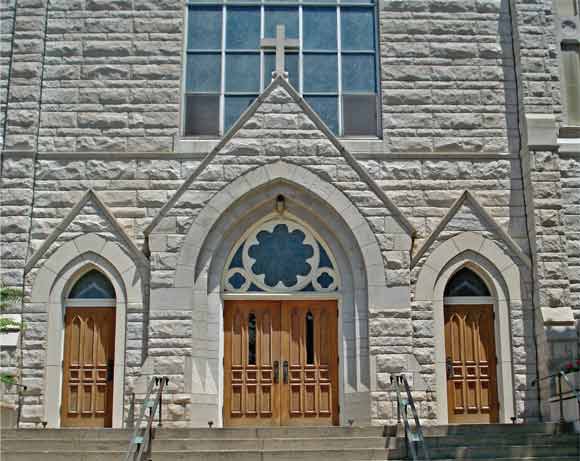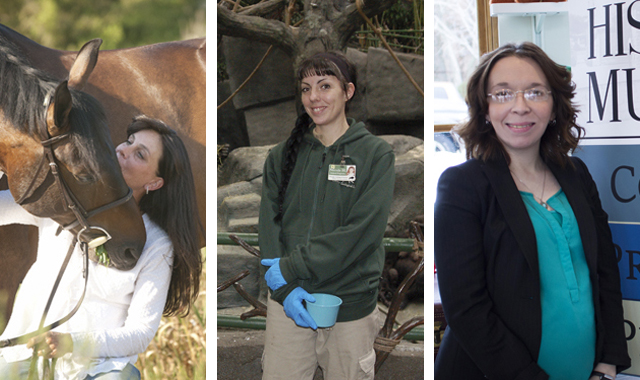“Faith is not something to grasp; it is a state to grow into.” –Mohandas Gandhi
Organized religion played a major role in settling Illinois and continues to influence the culture of our region. We enjoy highlighting places of worship, one in the country and one in the city, in each issue.
Country Church

Est. 1868 • 27570 Volo Village Road, Volo, Ill. • (815) 385-5496 • stpetervolo.org
The German immigrants who farmed this little burg, originally known as Folksville, saw the first church they built in 1886 burn to the ground, on the verge of its dedication and first scheduled Mass. They rebuilt and persevered as a mission church for nearly 40 years, becoming a self-supporting parish in 1904.
The second pastor was charged by Archbishop Mundelein in 1916 to help Volo to get a new church, but his mission was delayed by World War I, which caused building material costs to skyrocket. The parish of 44 families didn’t celebrate its 50th anniversary, vowing to wait until the Golden Jubilee could be commemorated in its new facility.
The old buildings were purchased and moved in 1920, and the cornerstone for the new building was laid in October 1925. To keep costs down, the men of the parish used their own teams, plows and shovels to do the excavating and ready the ground for construction.
These same men also hauled more than 5 million bricks and thousands of loads of gravel, lumber and cement five miles from the Chicago, Milwaukee & St. Paul railroad to the building site. Final cost was estimated at $100,00 for a new Gothic-style church, up-to-date school and attached convent, which were dedicated in July 1927. The interior features beautiful stained-glass windows and statuary, along with an ornate sanctuary and altar.
The school was staffed by a variety of lay teachers and sisters of various orders until 1960, when it closed. It is now used for church meetings and confirmation classes.
St. Peter stayed a rural parish, made up mostly of about 45 families of dairy farmers, for another 50-plus years, until suburban spread reached Volo. It now has a membership of more than 250 families, led by Fr. Eduardo Garcia, pastor.
Masses are held in Extraordinary Form Latin (EO) and Ordinary Form (OF) English and Spanish. Times: Monday through Friday, 6:15 a.m. EO, 8 a.m. OF; Saturday, 8 a.m. EO, 6 p.m. OF; Sunday, 8 & 9:30 a.m. OF, noon EO, 6 p.m. OF-Spanish. ❚
City Church

Est. 1850 • 302 Fisk Ave., DeKalb, Ill. • (815) 758-5432 • stmaryparish.org
Made of blue Bedford stone and adorned with 24 stained glass windows, this Gothic revival building in DeKalb County is home to a thriving parish, which celebrated the 100th anniversary of its current structure in 2001.
Founded in about 1850, 30 Roman Catholic families took turns holding Mass in each other’s homes, led on a rotating schedule by priests from Chicago or nearby St. Charles. By 1861, St. Mary Parish was appointed its first pastor, Fr. John Murray, whose drive got the church completed by the fall of 1861. Four years later, when he passed away, he was interred under the floor of the wooden church for which he worked so hard.
The foundation for a new, larger church was laid in 1899. Located on the same city block, but on the corner directly opposite its former location, it was dedicated with a special Mass in October 1901. A rectory was built, just west of the church, in 1904.
St. Mary School opened in 1913, and new wings were added in 1954 and 1957, to accommodate more than 500 teachers and students. An arson fire in 1973 completely destroyed the church’s sanctuary; however, all but one of the original stained glass windows, brought from Germany, survived. St. Mary School relocated to a newly remodeled building on Gurler Road in 1996, and has a current enrollment of about 240. Today’s confirmed church membership of more than 1,400 families is led by Fr. Kenneth Anderson, pastor.
Mass is held in English on Saturday at 4:30 p.m., Sunday at 8, 9:30 and 11 a.m., and on Holy Days at 7 a.m. and 5:30 p.m.; in Spanish on Sunday at 4 p.m.; and in Vietnamese on the second Sunday of the month, at 1:30 p.m. ❚




















































